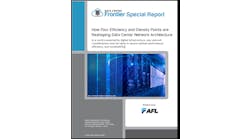Interconnection is a core service of most data center colocation providers that supports many-to-many connections between entities for rapid data exchange as well as an on-ramp to cloud services. It is the fastest-growing segment of the colocation industry. This launches our special report series on Virtual Interconnections.
In this special report, Christian Koch, senior director of interconnection for DataBank, shared his organization’s perspective on what will be the hub of the near-term future of software-driven IT infrastructure.
Call it the Great Decentralization of business.
With digital transformation accelerating market dynamics across nearly every industry, businesses are under pressure to become more agile and responsive. The growth of software-as-a-service, edge computing, and high-speed 5G and Wi-Fi 6 networks enable businesses to go to market more quickly and to improve upon them in real-time in the field. The new breed of virtualized interconnection services from colocation providers enable unprecedented flexibility for businesses to distribute computing resources and move intelligence closer to the point at which decisions are made.
The agility of small teams that was highlighted by the COVID-19 crisis will “hasten the progress to more decentralized global value chains,” wrote three Boston Consulting Group executives in the Harvard Business Review. McKinsey recently agreed, noting that “a flatter organization that delegates decision making down to a dynamic network of teams is more effective” than a hierarchical one.
The bottom line is that few companies can afford the luxury of long decision cycles and rigid chains of command any longer.
Enterprises are increasingly delegating responsibilities to those closest to products and customers while shedding low-value non-strategic operations. Technology is enabling this shift by supporting high-speed communications between business stakeholders, suppliers and customers. It’s also facilitating a more distributed workforce model with people working at home, on-site with customers, and in satellite offices. Global Workplace Analytics estimates that between 25% and 30% of the workforce in developed economies will be working-from-home multiple days a week by the end of 2021.
Finally, the rules of engagement are shifting. Success used to be defined by the ability of organizations to deliver a complete set of branded solutions. The winners in the new economy, however, are those that grow the entire market by building platforms upon which others innovate. Hierarchical corporate structures are being replaced by organic ecosystems of partners and suppliers.
Organizations are also learning to expose data to partners, contractors, and customers to foster alliances and generate new sources of revenue. Intellectual capital advisory firm Ocean Tomo has estimated that data now makes up more than 90% of the market value of S&P 500 companies. While some pundits have suggested the data is the new oil, the reality is that data is more valuable than oil because it can be reused, combined, and turned into insights that create a competitive advantage.
Cloud platforms create aggregation and distribution points for organizations to gather and expose data selectively, whether for a price or to enhance business partnerships. Flexible, open networks enable frictionless collaboration and commerce to occur at scale.
In short, the future of business will be distributed yet constantly connected, facilitated by cloud computing, intelligent devices, real-time data analytics, seamless collaboration, and high-speed networks.
Download the full report, How Virtual Interconnection Supports Distributed Digital Business, courtesy of DataBank to learn more. In our next article, we’ll look at why the future is software driven.





